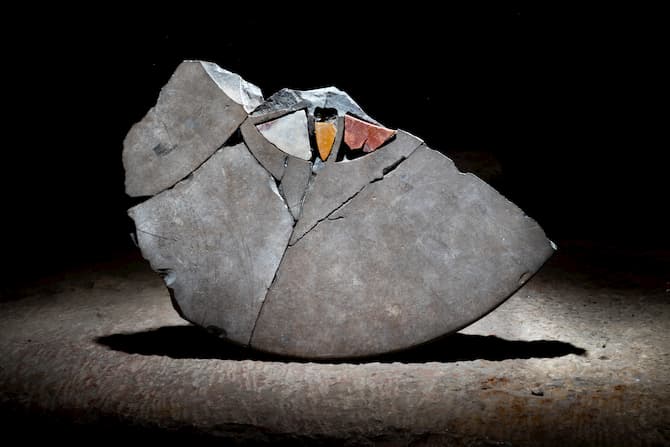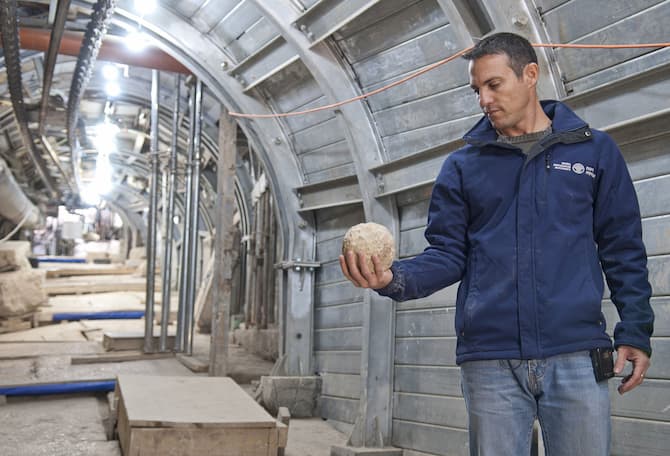According to Dr Joe Uziel, Ari Levy, Nachshon Szanton and Moran Hagbi, Directors of excavations on behalf of the Israel Antiquities Authority: “The impressive street and the buildings that were exposed along its length testify to the fact that a wealthy population lived here, the most significant discoveries that contributed to this understanding were publicly shown for the first time during the inaugural event, including broken parts of an ornate stone table, an additional round table made of bitumen stone decorated with colored stones in its center.” These are just some of the many tables discovered in the excavations, that were overseen by researcher Frankie Schneider.
A number of silver coins were found nearby, most notably silver coins minted in the city of Tire in 33CE and which, according to testimony in the Talmudic Tractate of Bechorot, were used as Half Shekel Temple tithes during the late Second Temple period.
A variety of jewelry was unearthed, including a ring with a precious stone that was discovered inside a ritual bath, and pottery vessels and vials that were used to store perfume or oils.
The total length of the street that connected the Pool of Siloam in the south of the City of David to the foot of the Temple Mount is 600 meters long and approximately 8 meters wide. To date, the southern part of the street has been exposed to a total length of 350 meters. The magnificent street was paved with large stone slabs – as is customary in monumental construction throughout the Roman Empire.
The discovery of the street combined advanced and pioneering research methods, which strengthened the understanding that King Herod the Great was not solely responsible for the huge construction projects of Jerusalem at the end of the Second Temple period. As recent studies indicate that the street was built after the reign of Herod, probably during the time of the Roman procurator Pontius Pilate, who is also known to have sentenced Jesus to crucifixion.
According to the researchers: “This conclusion, in fact, sheds light on the history of Jerusalem in the late Second Temple period, and strengthens the recognition of the importance of the rule of the Roman procurators in shaping the image of Jerusalem.” From ruins found in a layer of ash from the time of Jerusalem’s destruction throughout the street, valuable information was derived about its history, as well as the dietary regime that was practiced in the besieged city during the uprising. 2000 years after the destruction of Jerusalem, we have managed to go back in time and actually touch the last moments of the city before it was destroyed. ”
US Ambassador to Israel David Friedman said: “The City of David brings biblical Jerusalem back to life. It enables every one of us to stroll the corridors where the ancient prophets of Israel gave voice to revolutionary ideals of freedom, liberty and human dignity, establishing values which became the intellectual and constitutional basis of our republic. It is our unique privilege as Americans to walk together with our Israeli counterparts on the just unveiled Pilgrimage Road, where our shared ancestors ascended the flagstone steps in prayer and blessing.”
Director of the City of David and Israel Prize Laureate, David (Davidle) Be’eri stated “In ancient times, the Pilgrimage Road paved the way for tens of thousands of pilgrims from across the land of Israel and the four corners of the globe on their way to the Temple. Soon millions of visitors from Israel and abroad will be able to walk once again on those very same stones. The Romans thought they had brought an end to Jewish life in Jerusalem, but today nothing could be further from the truth. The Jewish people have returned to Zion and reestablished our united capital here in Jerusalem.”
Yisrael Hasson, Director of the Israel Antiquities Authority said: “The stepped road project is an integral part of the unearthing of ancient Jerusalem which was approved at a cabinet meeting. The plan seeks to look at the sites of ancient Jerusalem from a comprehensive governmental planning and budgetary perspective, which will create a structured and complete visitor experience through this unique space. We are currently in the second phase of the plan, which will be a total game changer. This entire endeavor is part of the Israel Antiquities Authority’s new vision to initiate new ways to showcase our national heritage and culture.”
Shaul Goldstein, Director of the Israel Nature and Parks Authority said: “It is extremely moving to walk on the road on which Prophets, Kings, Cohanim and the entire Jewish nation walked on to reach the Temple Mount in ancient times. It’s been said that these stones have a
human heart. The City of David National Park has uncovered a lot, but there is still so much more to discover. Together with the Israel Antiquities Authority and the City of David Foundation we will continue to improve and develop the site for the good of the hundreds of thousands of visitors. In the near future we will also add Shaaraim –Khirbet Qeiyafa where David fought the enemy of his generation, the Giant Golaith.”
Dr. Yuval Baruch, Jerusalem Regional Archaeologist of the Israel Antiquities Authority, “Today, for the first time, one can walk along one of the main streets of ancient Jerusalem, get an impression of its sights and receive answers to fascinating historical questions that have been asked for more than 100 years about the history of Jerusalem during the Second Temple period. This is a natural continuation of the previous archaeological excavations at the site, which were begun by European and American researchers at the end of the 19th century. The results of these excavations determined for the first time that the biblical City of David was located on the eastern hill of Jerusalem, the capital of King David, where the administrative institutions of the Kingdom of Judah were concentrated. During the Second Temple period, the area was included within the boundaries of the extended city – a neighborhood called the Lower City. Among the important findings that were discovered then were sections of the stepped stone street from the time of the Second Temple, built over 600 meters from the city’s southern gates and the area of the Shiloah Pool, up north towards the Holy Basin. Six years ago we renewed archeological excavations along the street, and it was exposed in all its glory to the benefit of the thousands of visitors who could walk there. ”
In recognition of the importance of the site and the finds, Israel Antiquities Authority researchers chose to adopt advanced and pioneering research methods in the fields of natural sciences, biology and geology. The combination of these advanced methods turns the excavation of the stepped street in the City of David into one of the most exceptional excavations of in terms of scientific quality and its importance to the development of archeological research in Jerusalem in particular and in Israel in general, and enables researchers to deal with questions that have not yet been studied. The excavations reveal findings that will enable researchers to answer intriguing questions, such as: How did the main road leading to the Temple look? And what was the urban character of the lower city that stretched alongside the glorious road?
















